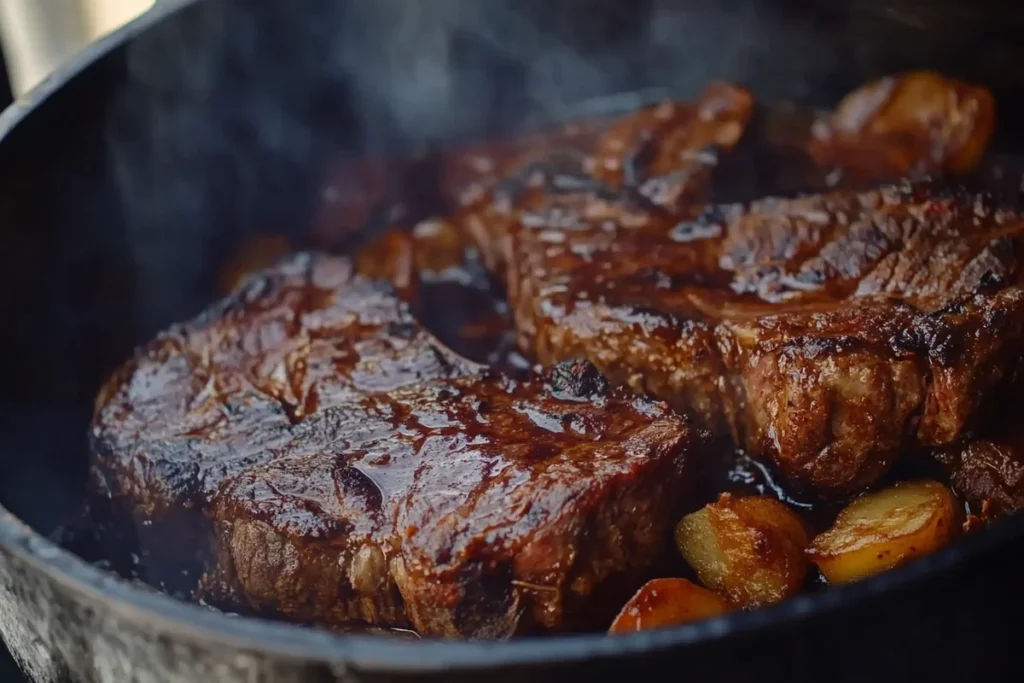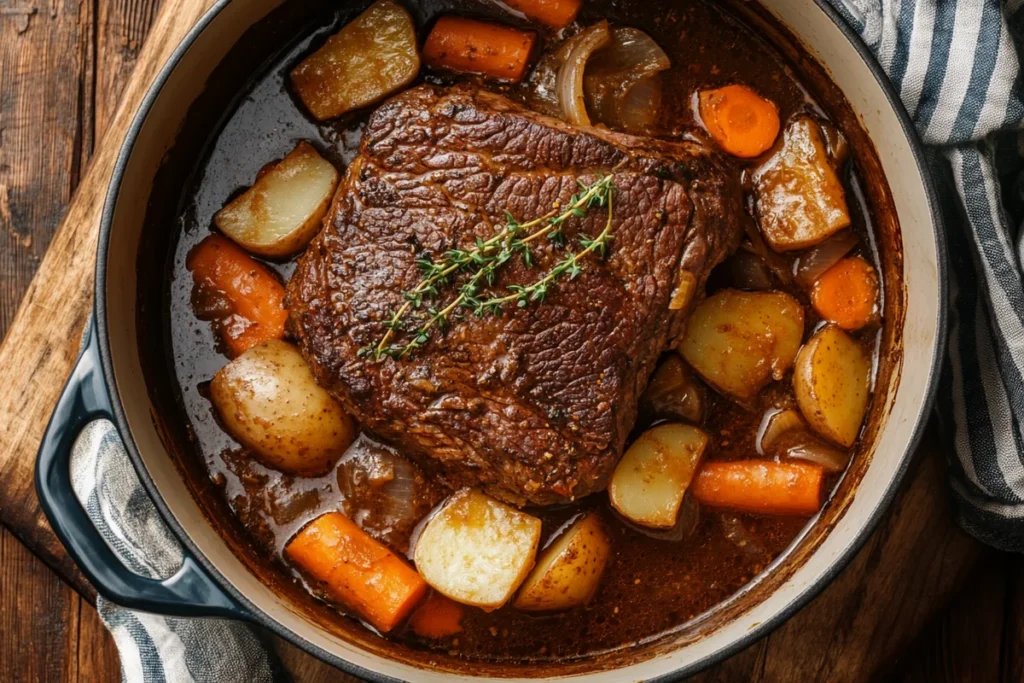This guide explores beef chuck steak, from selection to cooking. Learn tips and recipes for a tender, flavorful meal.
Table of Contents
- What is Beef Chuck Steak?
- Nutritional Value of Beef Chuck Steak
- Choosing the Best Cut of Beef
- Preparing the Steak for Cooking
- Cooking Methods for a Chuck Steak
- Recipes Featuring Chuck Steak
- Tips for a Tender Cut of Beef
- Serving Suggestions for Beef Chuck
- Storing this Cut of Beef
- Health Considerations for Beef Chuck
- Frequently Asked Questions (FAQs)
What is Beef Chunk Steak?
Beef chuck steak comes from the chuck primal, located in the shoulder area of the cow. Consequently, this area is well-exercised. Therefore, it tends to be tougher than other cuts. However, with the right cooking methods, it transforms into a flavorful and tender delight. In addition, its marbling contributes significantly to its taste. Ultimately, it’s a cost-effective choice for many dishes.
Understanding the Chuck Primal
The chuck primal is a large section of the cow. This section includes several different cuts of meat. This particular steak is just one of them. This area provides flavor because of its fat. It also provides connective tissue.
Different Types of Chuck
Several types of chuck cuts exist. These types vary in tenderness and marbling. For example, chuck eye steak is often called “the poor man’s ribeye” because it’s located next to the ribeye. Flat iron steak also comes from the chuck. It is valued for its tenderness. Additionally, Denver steak is gaining popularity. It is known for rich flavor.

Nutritional Value of Beef Chuck Steak
This type of beef offers several nutrients. However, the specific content varies based on factors such as the animal’s diet, and how the meat is trimmed.
Macronutrient Breakdown
Generally, a chuck steak is a source of protein. It also contains fat. The amount of fat impacts the overall calorie count. For example, a leaner cut has fewer calories, while a more marbled cut has more.
Vitamins and Minerals
This beef also provides various vitamins and minerals. For example, it is a source of iron, which is important for blood health. Furthermore, it includes zinc, which supports the immune system. Additionally, you’ll find B vitamins. B vitamins aid in energy production. Selenium is also present and acts as an antioxidant.
Health Benefits and Considerations of Chuck
The protein in beef chuck is crucial for muscle building and repair. However, it is important to eat meat in moderation. Choosing leaner cuts helps, which reduces intake of saturated fat, therefore promoting heart health. Considering the health benefits makes beef chuck a viable choice for many.
Choosing the Best Cut of Beef
Selecting quality beef matters. It impacts the outcome of your meal. Consider these factors when buying.
Marbling and Fat Content
Marbling refers to the streaks of fat within the meat. Moreover, more marbling generally means more flavor and tenderness. Look for steaks with even marbling throughout. However, avoid excessive external fat.
Color and Texture
A good chuck steak should have a bright red color. Consequently, this indicates freshness. Avoid steaks that look brown or gray. The texture should be firm, and it should spring back when touched.
Cut Thickness and Shape
Choose a steak that is uniformly thick. Uniform thickness ensures even cooking. The shape is also important, as a consistent shape helps with heat distribution.
Where to Buy High-Quality Beef
Purchase your beef from trusted sources. For example, reputable butchers or grocery stores. Therefore, ensure proper handling and storage. Local farms are an excellent option as well. They can provide high-quality meat.
Preparing the Steak for Cooking
Proper preparation enhances the steak’s flavor and improves its tenderness. These steps will guide you.
Trimming and Cleaning
Trim excess fat from the steak. However, leave some fat for flavor. Remove any tough connective tissue, as this improves the texture.
Marinating Techniques
Marinating the beef is beneficial, consequently, it adds flavor, in addition, it helps tenderize the meat. Use acidic ingredients in your marinade, for example, vinegar or citrus juice. Seasoning with herbs and spices enhances the flavor.
Dry Brining
Dry brining is another method. Salt the beef generously. Then, refrigerate it for several hours. Therefore, this helps the meat retain moisture, and enhances the flavor as well.
Bringing to Room Temperature
Before cooking, let the steak sit at room temperature for about 30-60 minutes. Therefore, this ensures even cooking.

Cooking Methods for a Chuck Steak
A chuck steak can be cooked in several ways. Each method offers unique results. Here are some popular methods.
Braising the Chuck Steak
Braising is ideal. This method breaks down tough fibers. Braising involves searing the meat, then cooking it slowly in liquid, which leads to a very tender steak.
Slow Cooking
Slow cooking also works well. The slow cooker tenderizes the meat. Add seasoning, broth, and vegetables. Cook on low for several hours.
Grilling
Grilling adds smoky flavor. Marinate the beef first. Grill over medium heat. Avoid overcooking.
Pan-Searing
Pan-searing is a quick method. Use a hot skillet. Sear each side to create a crust. Then, finish cooking in the oven.
Sous Vide
Sous vide offers precise cooking. Seal the beef in a bag. Cook in a water bath. Finish with a quick sear.
Recipes Featuring Chuck Steak
Chuck steak is versatile. Therefore, it can be used in many recipes. Here are a few ideas.
Classic Beef Stew
This cut is perfect for beef stew. Its flavor enriches the broth. Cut the beef into cubes. Brown it before adding vegetables. Simmer until the meat is very tender.
Pot Roast
Pot roast is a comfort food. Sear the beef. Then, place it in a Dutch oven. Add carrots, potatoes, and onions. Braise until tender.
Beef Stroganoff
For beef stroganoff, slice the beef thinly. Sauté it with mushrooms and onions. Add sour cream and serve over noodles.
Grilled Steak with Chimichurri
Marinate the beef. Grill it to your liking. Top with chimichurri sauce, which adds freshness.
Slow Cooker Barbacoa
Slow cooker barbacoa uses beef. Season the meat. Cook with spices and broth. Shred it and use in tacos or burritos.
Tips for a Tender Cut of Beef
Achieving a tender cut requires attention. Consider these tips.
The Importance of Low and Slow Cooking
Low and slow cooking is crucial, allowing the connective tissue to break down, resulting in very tender meat. This is particularly important for tougher cuts.
Proper Searing Techniques
Searing creates a crust and enhances flavor. Use high heat. Sear each side before cooking.
Using Meat Tenderizers
Meat tenderizers can help break down tough fibers. Use a meat mallet, or try a marinade with acidic ingredients.
Cutting Against the Grain
After cooking, slice the beef against the grain. This shortens the muscle fibers, making the meat easier to chew.
Resting the Meat
Let the beef rest before slicing for about 10-15 minutes. This allows the juices to redistribute, thus resulting in more moisture.
Serving Suggestions for Beef Chuck
Serving beef chuck creatively enhances the meal. Here are some suggestions.
Pairing with Side Dishes
This type of beef compliments many side dishes. For example, mashed potatoes. Roasted vegetables are also a good choice. A simple salad adds freshness.
Sauce Recommendations
Pair this beef with flavorful sauces. Red wine reduction compliments the richness. Chimichurri adds brightness. Horseradish sauce provides a kick.
Garnishing Ideas
Garnish attractively. Fresh herbs like parsley or thyme add color. A sprinkle of sea salt enhances the flavor.
Creative Plating Techniques
Plate the beef thoughtfully. Arrange the meat and side dishes attractively. Add a drizzle of sauce. This creates an appealing presentation.
Storing this Cut of Beef
Proper storage preserves the quality of the beef. Here are some tips.
Refrigeration Guidelines
Store raw beef in the refrigerator. Keep it at 40°F (4°C) or below. Use it within 3-5 days. Wrap it tightly to prevent drying.
Freezing Techniques
Freeze beef for longer storage. Wrap it in freezer paper, or use freezer bags. Remove as much air as possible. Frozen beef can last for several months.
Thawing Methods
Thaw the beef safely, either in the refrigerator or using the cold water method. Never thaw at room temperature, as this prevents bacterial growth.
Leftover Storage
Store cooked beef properly. Refrigerate it within two hours in airtight containers. Consume within 3-4 days.

Health Considerations for Beef Chuck
When eating beef chuck, consider health factors.
Moderation and Portion Control
Eat beef in moderation. Portion control is important. Follow serving size guidelines.
Choosing Leaner Cuts
Select leaner cuts. This reduces fat intake. Trim visible fat before cooking.
Preparing with Healthy Methods
Use healthy cooking methods such as baking, grilling, or broiling. Avoid frying.
Balancing with a Healthy Diet
Combine beef with a balanced diet. Include plenty of vegetables, fruits, and whole grains. This ensures a range of nutrients.
Frequently Asked Questions (FAQs)
What is beef chuck steak good for?
Beef chuck steak is good for braising, slow cooking, stews, and pot roasts. It becomes very tender with slow cooking methods. It can also be grilled after marinating to add flavor.
What is the best way to cook a beef chuck steak?
The best way to cook beef chuck steak is through braising or slow cooking. These methods break down the tough fibers. Sear the beef first to develop flavor. Afterwards, cook it in liquid at a low temperature.
How long does it take for a chuck steak to get tender?
This cut takes several hours to become tender. Braising or slow cooking may take 3-4 hours. Ensure the internal temperature reaches at least 200°F. The long cooking time breaks down connective tissues, tenderizing the beef.
Is beef chuck steak a tough cut of meat?
Beef chuck steak is considered a tougher cut due to the muscle fibers. However, with proper cooking, such as braising or slow cooking, it becomes very tender. Marinating can also help tenderize the beef.

